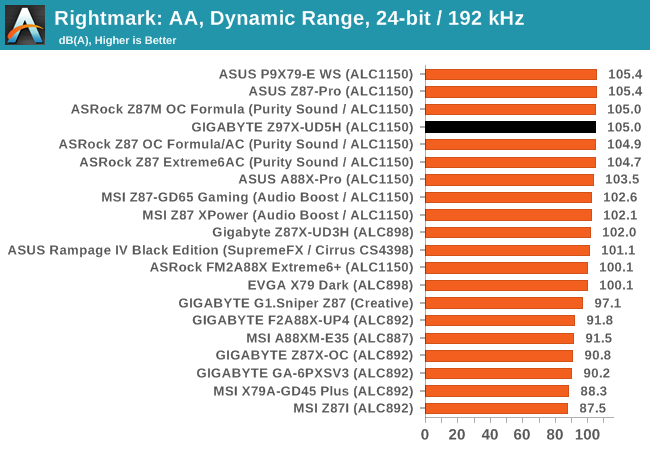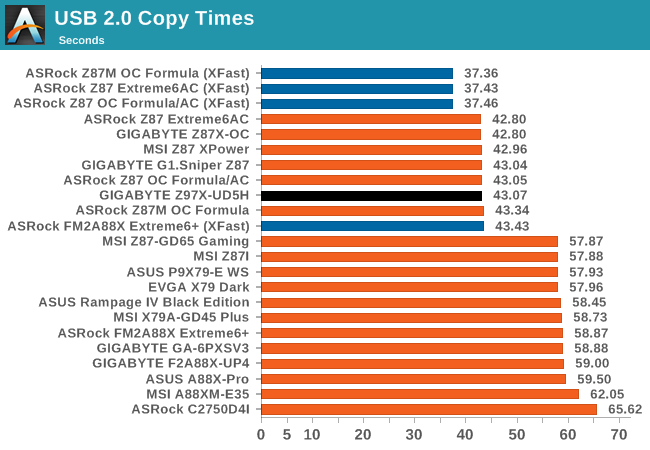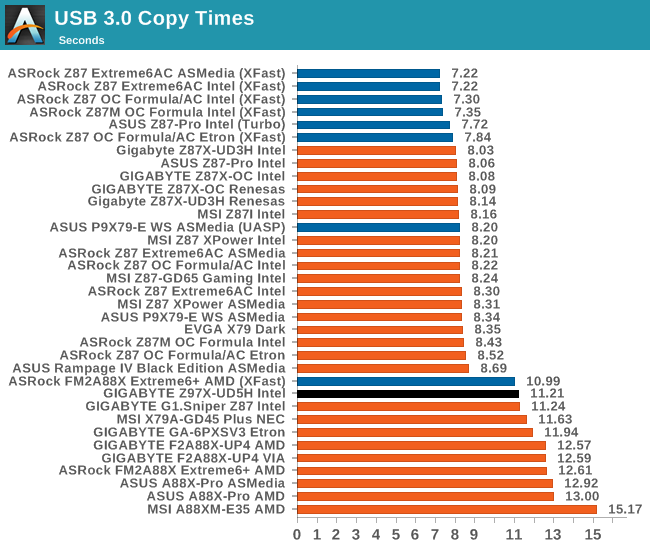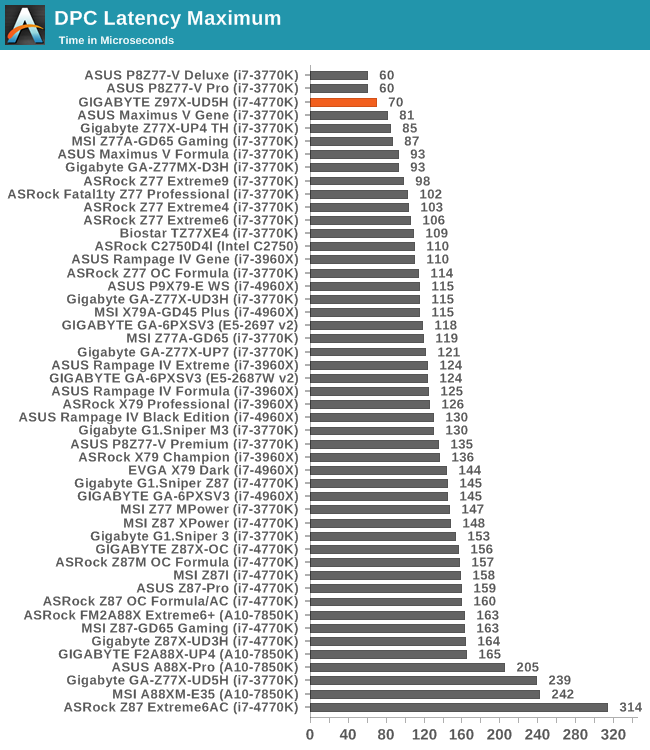GIGABYTE Z97X-UD5H Review: Choose Your Storage Option
by Ian Cutress on May 14, 2014 9:00 AM EST- Posted in
- Motherboards
- Intel
- Gigabyte
- Z97
System Benchmarks
Rightmark Audio Analyzer 6.2.5
The premise behind Rightmark:AA is to test the input and output of the audio system to determine noise levels, range, harmonic distortion, stereo crosstalk and so forth. Rightmark:AA should indicate how well the sound system is built and isolated from electrical interference (either internally or externally). For this test we connect the Line Out to the Line In using a short six inch 3.5mm to 3.5mm high-quality jack, turn the OS speaker volume to 100%, and run the Rightmark default test suite at 192 kHz, 24-bit. The OS is tuned to 192 kHz/24-bit input and output, and the Line-In volume is adjusted until we have the best RMAA value in the mini-pretest. We look specifically at the Dynamic Range of the audio codec used on board, as well as the Total Harmonic Distortion + Noise.
Dynamic Range of the Z97X-UD5H


While the dynamic range of the UD5H was good, the THD+N was low - this is indicative of a driver issue we encountered. Not unique to the UD5H, but the disk drivers we were provided causes a lot of distortion at 100% speaker volume. On other motherboards with the same codec, an audio driver update fixed the issue, and we assume it will be similar for the UD5H.
USB Backup
For this benchmark, we run CrystalDiskMark to determine the ideal sequential read and write speeds for the USB port using our 240 GB OCZ Vertex3 SSD with a SATA 6 Gbps to USB 3.0 converter. Then we transfer a set size of files from the SSD to the USB drive using DiskBench, which monitors the time taken to transfer. The files transferred are a 1.52 GB set of 2867 files across 320 folders – 95% of these files are small typical website files, and the rest (90% of the size) are the videos used in the WinRAR test. In an update to pre-Z87 testing, we also run MaxCPU to load up one of the threads during the test which improves general performance up to 15% by causing all the internal pathways to run at full speed.


DPC Latency
Deferred Procedure Call latency is a way in which Windows handles interrupt servicing. In order to wait for a processor to acknowledge the request, the system will queue all interrupt requests by priority. Critical interrupts will be handled as soon as possible, whereas lesser priority requests, such as audio, will be further down the line. So if the audio device requires data, it will have to wait until the request is processed before the buffer is filled. If the device drivers of higher priority components in a system are poorly implemented, this can cause delays in request scheduling and process time, resulting in an empty audio buffer – this leads to characteristic audible pauses, pops and clicks. Having a bigger buffer and correctly implemented system drivers obviously helps in this regard. The DPC latency checker measures how much time is processing DPCs from driver invocation – the lower the value will result in better audio transfer at smaller buffer sizes. Results are measured in microseconds and taken as the peak latency while cycling through a series of short HD videos - less than 500 microseconds usually gets the green light, but the lower the better.

Hurrah, it looks like the DPC Latency issues around Z87 are gone! With Z87, every motherboard we tested was >140 microseconds on DPC Latency, but it looks like Z97 is going straight to the top of our testing. Other motherboards we are currently testing show similar results at the top end of our results.











53 Comments
View All Comments
TelstarTOS - Thursday, May 15, 2014 - link
http://www.samsung.com/global/business/semiconduct...Get one of these and test all the Z97 M.2 port with it.
izdlang - Wednesday, August 27, 2014 - link
So I see on the website that there is now a revision 1.1.. I ordered a new one, and got revision 1.0. Does anyone know what the difference in the revisions are? Want to know if I should whine until I get a 1.1 vs the 1.0?swing848 - Tuesday, September 9, 2014 - link
Thank you for the review. I noticed that you are still pushing Nvidia ... You are comparing an GTX 770 to an AMD HD 7970. How many people are currently purchasing HD 7970 video cards?You could use an AMD R9 290 and an GTX 670, that would be just as fair ... come on, I know [Anand] has more than two video cards to use. This is pure Nvidia bias.